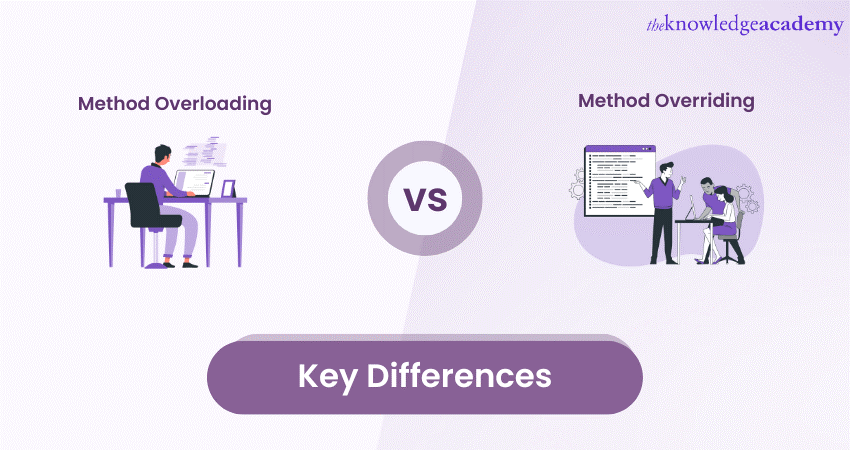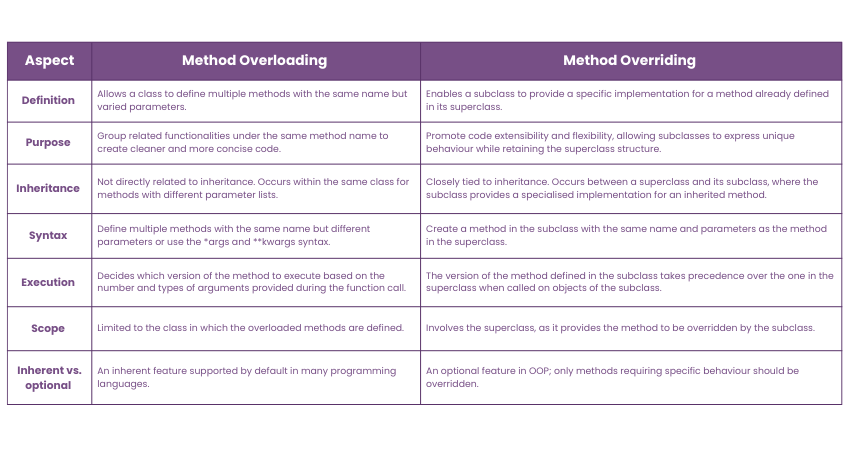We may not have the course you’re looking for. If you enquire or give us a call on 01344203999 and speak to our training experts, we may still be able to help with your training requirements.
Training Outcomes Within Your Budget!
We ensure quality, budget-alignment, and timely delivery by our expert instructors.

Are you a Python Developer or a programming enthusiast eager to expand your knowledge in Object-Oriented Programming (OOP)? If yes, understanding the difference between Method Overloading and Method Overriding in Python is essential for harnessing the full potential of its object-oriented capabilities.
Method Overloading and Method Overriding in Python are two powerful concepts that enhance code flexibility and promote code reusability. However, these concepts remain poles apart when it comes to creating more versatile and adaptable code structures.
So, to develop more structured codes, it’s time to understand the difference between these concepts. Read this blog to take a closer look at Method Overloading and Method Overriding in Python and then analyse the main differences between them.
Table of contents
1) What is Method Overloading?
2) Understanding Method Overriding
3) Method Overloading and Method Overriding: Key differences
a) Definition
b) Purpose
c) Inheritance
d) Syntax
e) Execution
f) Scope
g) Inherent vs. optional
4) Conclusion
What is Method Overloading?
Method Overloading is a fundamental concept in OOP that enables a class to define multiple methods with the same name but different parameters. In Python, this powerful feature allows developers to create versatile functions capable of handling various data types. It also helps perform distinct operations based on the types and number of arguments passed.
When a method is overloaded, Python determines which version of the method is to be executed based on the arguments provided during the function call. By using Method Overloading, programmers can create cleaner and more concise code. It is because related functionalities can be grouped under the same method name.
Moreover, Method Overloading empowers developers to build flexible and adaptive solutions. This makes Python the best choice for projects that require intricate and diverse functionalities, such as managing different Python String operations, while maintaining a streamlined and organised codebase. Consider the following code example:
|
class MathOperations: def add(self, a, b): return a + b
def add(self, a, b, c): return a + b + c
def add(self, a, b, d): return a + b + d |
In this example, defined three versions of the "add" method have been defined. Each method is capable of handling a different number of arguments. Python will use the method that matches the number of arguments provided during the function call.

Understanding Method Overriding
Method Overriding is another crucial concept in OOP) that empowers subclasses to provide a specific implementation for a method already defined in their superclass. In Python, this powerful feature allows developers to tailor the behaviour of a method in a subclass to suit the unique requirements of that subclass.
When a method is overridden, the version defined in the subclass takes precedence over the one in the superclass. This principle of polymorphism enables objects of the subclass to be used interchangeably with objects of the superclass. A strong grasp of Python Data Structures supports this principle by helping you manage and manipulate data efficiently, thereby promoting code extensibility and flexibility.
Method Overriding is particularly useful in scenarios where a subclass needs to enhance or modify the functionality inherited from its superclass while maintaining the overall structure and interface. By doing so, developers can efficiently reuse existing code and create specialised classes that build upon the foundation of more general ones.
Further, through this method, Python Developers can craft intricate and adaptable class hierarchies. This helps facilitate the creation of sophisticated applications with well-organised and maintainable code.
Additionally, this feature solidifies Python’s position as a prominent language for object-oriented programming. As a result, it provides developers with the tools they need to build elegant and efficient solutions. Consider the following code example:
|
class Shape: def area(self): pass
class Square(Shape): def __init__(self, side): self.side = side
def area(self): return self.side * self.side |
In this example, there is a superclass called "Shape" with a method "area" that is meant to be overridden. The "Square" subclass overrides the "area" method to calculate the area of a square based on its side length.
Unlock endless possibilities for creating dynamic web applications by joining our Python Django Training.
Key differences between Method Overloading and Method Overriding
While both techniques involve the reuse of method names, they serve different purposes and have distinct implementations. Understanding the key differences between Method Overloading and Method Overriding in Python is essential for creating efficient and maintainable code. Let's explore these differences in detail:

1. Definition
Method Overloading offers a class to define multiple methods with similar names but varied parameters. Each method can handle a different set of arguments, enabling the same method name to be used for various operations. A thorough understanding of Python Data Types is crucial for effectively utilizing method overloading, as it helps in managing and distinguishing between different argument types.
In contrast, Method Overriding enables a subclass to provide a specific implementation for a method that is already defined in its superclass. The subclass's method replaces the method of the same name in the superclass, allowing for a customised behaviour.
2. Purpose
The primary purpose of Method Overloading is to create more concise and readable code by grouping related functionalities under a single method name. It improves code organisation and reduces the need for multiple function names.
Whereas Method Overriding is used to promote polymorphism and inheritance in OOP. It allows subclasses to express their unique behaviours while inheriting the structure and interface of the superclass.
3. Inheritance
Method Overloading is not directly related to inheritance. It occurs within the same class and provides different implementations for methods based on the parameters provided during the function call. On the other hand, Method Overriding is closely tied to inheritance. It occurs between a superclass and its subclass, where the subclass provides a specialised implementation for a method inherited from the superclass. In multi-threaded applications, managed using Python Threading, understanding both Method Overloading and Method Overriding becomes important for ensuring that methods are executed correctly across different threads.
4. Syntax
In Python, Method Overloading is achieved by defining multiple methods with the same name within a class but with different parameter lists or using the *args and **kwargs syntax. In contrast, Method Overriding in Python involves creating a method in the subclass with the same name and parameters as the method in the superclass.
Unlock the power of Visual Basic programming - Join our Visual Basic Programming For .NET Course now!
5. Execution
During Method Overloading, Python decides which version of the method is to be executed based on the number and types of arguments provided during the function call. In Method Overriding, the version of the method defined in the subclass takes precedence over the one in the superclass when called on objects of the subclass.
6. Scope
The scope of Method Overloading is limited to the class in which the overloaded methods are defined. In comparison, Method Overriding occurs in the context of inheritance, where the subclass can override methods inherited from its superclass.
7. Involvement of superclass
Method Overloading does not involve the superclass. It deals solely with defining multiple versions of a method within the same class. While Method Overriding directly involves the superclass, as it provides the method to be overridden by the subclass.
8. Inherent vs. optional
In many programming languages, Method Overloading is an inherent feature and is supported by default. In contrast, Method Overriding is an optional feature in OOP. Not all methods in a subclass need to be overridden; only those requiring specific behaviour should be overridden.
Conclusion
Method Overloading and Method Overriding in Python are two indispensable tools. They empower developers to create versatile and well-structured object-oriented programs. By understanding the differences between these key concepts, developers can harness their power effectively and build efficient and maintainable codebases.
Enhance your data visualisation skills today by signing up for our Data Visualization Training With D3 Course.
Frequently Asked Questions
Upcoming Programming & DevOps Resources Batches & Dates
Date
 Python Course
Python Course
Mon 20th Jan 2025
Mon 24th Mar 2025
Mon 26th May 2025
Mon 28th Jul 2025
Mon 22nd Sep 2025
Mon 17th Nov 2025







 Top Rated Course
Top Rated Course


 If you wish to make any changes to your course, please
If you wish to make any changes to your course, please


